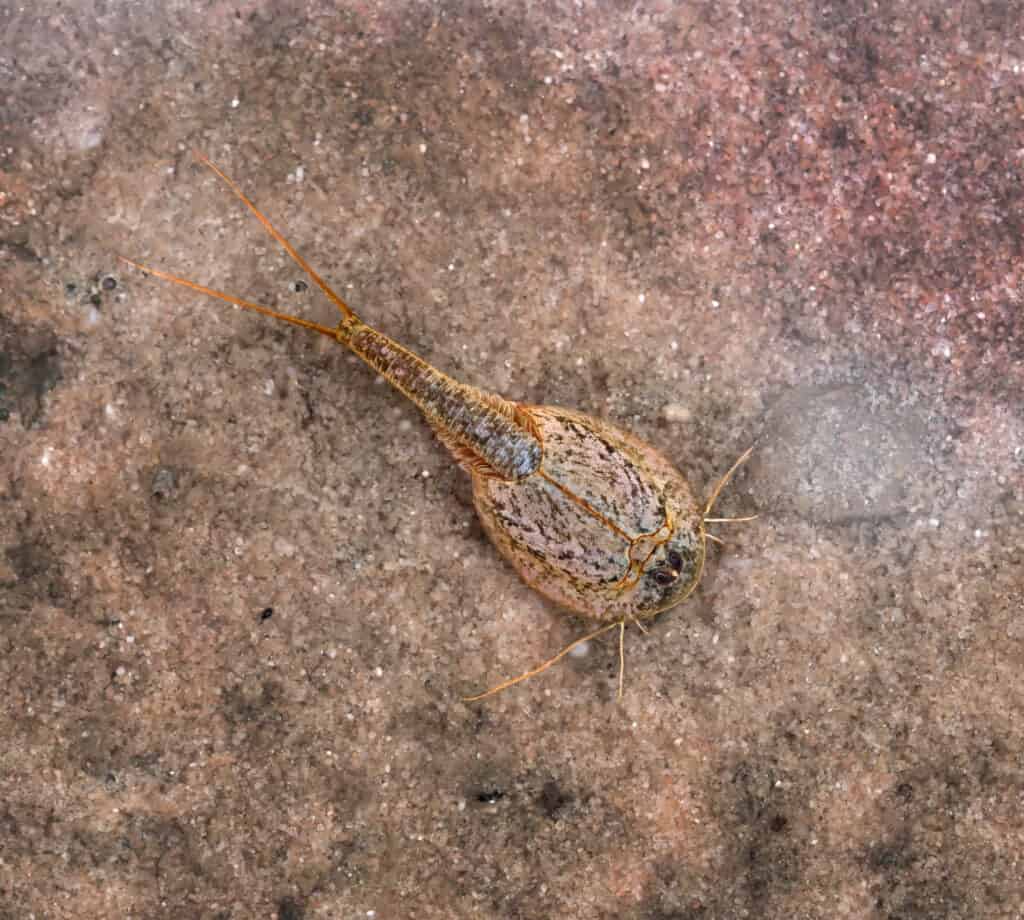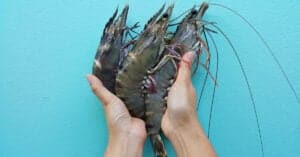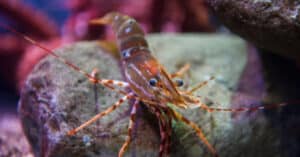The Triops longicaudatus, also known as the American tadpole shrimp and the longtail tadpole shrimp, engages in a process of delayed egg hatching called “diapause.” You may be curious about this odd reproductive process and about this creature in general. In this article, we cover some interesting facts about the Triop, a dinosaur-like shrimp with three eyes! We also explore the process in which it delays its eggs from hatching for as long as 27 years!
About the Triop

is a freshwater crustacean.
©IrinaK/Shutterstock.com
This shrimp, Triops longicaudatus, has been given the nickname “tadpole” due to its resemblance to the larval stage of a frog. The tadpole shrimp is relatively large, measuring 10–40 mm in length, 3–8 mm in breadth, and weighing 2–2.5 g. The body is usually a brown or grayish-yellow tint, and it consists of a head, a thorax, and an abdomen. Near the middle of its belly, it possesses a cluster of tiny, hairlike appendages (about 60 in all). Alongside its two compound eyes, this species also has a third, middle eye, making it one of a kind!
This shrimp lives at the base of freshwater ponds that are about 4 feet deep and 30 by 60 feet. They are heated to a comfortable 21 to 31 degrees Celsius. The water in the pools they inhabit remains a constant temperature for around a month. These tadpole shrimp spend their days at the pool’s bottom, where they dig and look for food. T. longicaudatus is nocturnal, and it prefers to spend the night buried in the pool’s silt.
They can be found across North America, South America, the Caribbean, Japan, and some of the Pacific Islands. This tadpole shrimp can be found in the continental United States, Hawaii, and Puerto Rico, but not in Alaska.
The Triops Process of Diapause
After fertilization, a female protects her eggs for several hours while they develop inside the egg sac. The female will subsequently lay her eggs, which are typically white in color, on various surfaces in the pool. She will alter her eggs, so they go dormant if she senses that survival conditions are not optimal.
A triops egg has an alveolar layer composed of hundreds of tiny chambers linked by a spongy matrix. An egg is less than 0.5 mm in diameter. Liquid enters the alveolar layer as soon as the egg is laid. The egg then sinks. Here, amid the silt, the eggs wait to hatch. There is less danger of being devoured by adult triops here. After the water dries, air replaces the fluid in the alveolar layer. When the eggs are wet, if they aren’t buried in silt, they float to the surface, where the suns warm them. When an egg is exposed to light, it knows it is no longer concealed and may begin the hatching process. They are reburied if they do not hatch, protecting them from being eaten by their siblings.
Did you know that scientists believe these eggs can continue to “survive” for considerably longer than 27 years? The eggs are resistant to extremes of cold and heat (although not boiling). A few key conditions, which we cover today, determine how well this delayed hatching works.
The Hatching Process
The larvae develop from the eggs after they hatch. Meta nauplius describes the initial stage of larval development. The orange meta nauplius has three sets of legs and a single eye at this stage in its development. The meta nauplius starts developing its tail (called the telson) and shedding its exoskeleton after many hours. At the end of another 15 hours, the larval has lost its exoskeleton once more and resembles a little adult. Over the next few days, it will reach its full adult size as it continues to molt. When the tadpole shrimp has developed for seven days, it turns a brownish color and is ready to reproduce.
The Importance of Specific Conditions

live in freshwater habitats.
©marketa1982/Shutterstock.com
In the case of triops eggs, they can endure years of full dehydration and lack of metabolic activity. They will not hatch unless optimum conditions occur. The right type of water will cause the egg to hatch, along with osmotic pressure, temperature, and exposure to light. In the right setting, the pool quickly fills up with water from rain or seasonal flooding. In this case, the water is mostly pure, contains few minerals or organics, and has an exceptionally low osmotic pressure.
Specifics vary depending on the species, but only a tiny proportion of eggs have a chance of hatching directly after being laid. The remaining eggs must be dried for at least one period before they can hatch. Some eggs will hatch after just one drying, while others won’t hatch until two or more cycles have taken place!
Why are the right circumstances so important? Triops are vulnerable to predators, especially when they are young. A body of water may be home to fish, amphibians, or aquatic insects that will kill the hatchlings quickly. Also, this body of water could be on the verge of drying up. The eggs won’t hatch until conditions reflect a new body of fresh water. Two especially crucial factors play into the proper conditions for diapause, which include ideal temperatures and water type.
Temperature
Typically, the ideal temperature range for hatching Triops eggs is between 59 and 86 degrees Fahrenheit. If the temperature is lower than optimal, growth will slow, and hatchlings might not be able to reach maturity before the pool dries up. The hatchlings won’t survive if the pool temperature hits its peak, and the surrounding air is too hot. Accordingly, the hatch rate is indicative of how near the eggs are to this optimum range.
Water Type
Second, the characteristics of the temporary bodies of water in which they live are critical. Almost nothing else can live in the extremely salty environments where these shrimps make their temporary home.
In Conclusion
Triops have adapted to temporary pools where there aren’t usually any predators bigger than them. They thrive in places with vastly different pH levels, like alkaline pools and acidic peat bogs. The triops have made their own special paradise in these unpredictable and changing specialized habitats.
A fast metabolism and rate of growth allows them to live their whole lives in a few liters of rainwater. Even eggs that have been dormant for over 10 years will hatch quickly once the right conditions return. They need anywhere from a few hours to a day to hatch.
It’s hard to believe that this ancient being is still using the same survival tactics it did millions of years ago. Their adaptations have worked well for them so far!
The photo featured at the top of this post is © IrinaK/Shutterstock.com
Thank you for reading! Have some feedback for us? Contact the AZ Animals editorial team.






